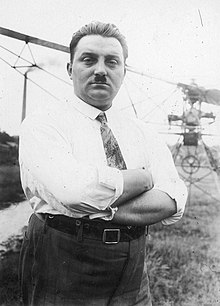Zaschka muscle power aircraft
| Zaschka muscle power aircraft | |
|---|---|

|
|
| Type: | Experimental airplane |
| Design country: | |
| Manufacturer: | |
| First flight: |
Flight attempts on July 11, 1934 in Berlin |
| Production time: |
1934 - was never mass-produced |
| Number of pieces: |
1 |

The Zaschka human-powered aircraft ( engl. Zaschka human Aircraft Power ; Zaschka-HPA) was the attempt of a muscle-powered aircraft , which in 1934 by the German inventor and Oberingenieur Engelbert Zaschka constructed in Berlin and has been tested.
When planning his aircraft, Zaschka recognized that a large wing extension with a low wing loading is of decisive importance for a flight with muscle power . Therefore, he equipped his construction with a 20 meter long, narrow wing. Wire bracing over a central, vertical spar stabilized the wing against deformation. The frame of the Zaschka muscle power aircraft was made of steel tubes. At the start it should be accelerated to the nominal airspeed by up to four men .
During flight attempts on July 11, 1934, Engelbert Zaschka was able to achieve hovering flights of 20 meters in length by plane in Tempelhof without outside help. However, the aircraft was too heavy for long-term flight. The materials available at that time did not allow controlled endurance flight with muscle power. It was another 40 years before Paul McCready designed the Gossamer Condor, the first aircraft that could fly a horizontal figure eight with muscle power.
Picture gallery
Engelbert Zaschka with his invention, Berlin 1934
Zaschka muscle power aircraft with inventor, American newspaper report, 1934
TV documentaries
- Big ideas - small flops: flashes of inspiration from A to Z. Documentation, Germany, 2016, 90 minutes, authors: Andreas Kölmel and Jürgen Vogt; Production: SWR TV , first broadcast: May 16, 2016; Documentation information ; Documentation excerpt "Zaschka": YouTube .
literature
- Karl Ries: Air Force. The Moles (1919–1935). Publisher Dieter Hoffmann, Mainz 1970.
- David Anthony Reay: The history of man-powered flight. Pergamon Press, Oxford / New York 1977, ISBN 0-08-021738-9 .
- Morton Grosser: Gossamer Odyssey: The Triumph of Human-powered Flight. Zenith Press, 2004, ISBN 0-7603-2051-9 .
Web links
- Image: The Zaschka Human-Power Aircraft and its inventor Engelbert Zaschka, 1934
- Image: The inventor chief engineer Engelbert Zaschka, in the driver's seat of his muscle-powered aircraft, April 1934

